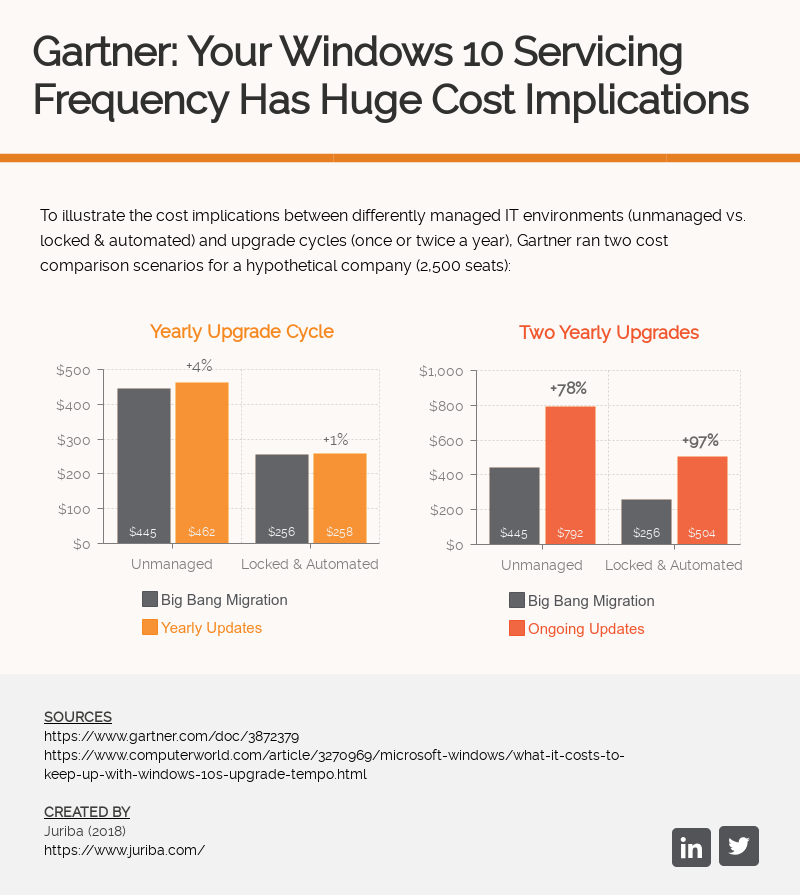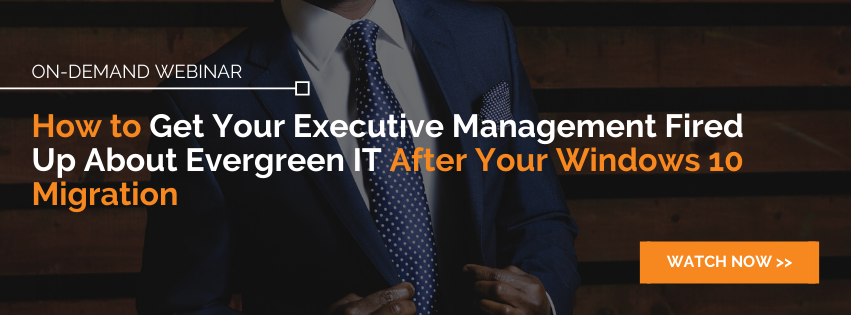8 Game-Changing Benefits Of Evergreen IT Management Your Boss Wants To Know
May 19th, 2020
5 min read
By Barry Angell

Instinctively, we all know that keeping our IT environment up-to-date is a good thing. Yet, despite the fact that the enterprise market is, by now, over the peak of initial Windows 10 migrations, many organizations still haven't found a good upgrade rhythm for the ongoing updates.
We call this perpetual updating of assets 'Evergreen IT'. Oftentimes, traditional migration teams handed things over to their Business-as-Usual counterparts once the initial migration was completed without having established Evergreen IT methodologies or processes in place to properly maintain the environment. Therefore, it often falls on the BAU team to not only create scalable, repeatable, and industrialized processes, but also sell Evergreen IT Management principles to their internal customers after-the-fact.
If you are in that position, we would like to make that sales job easier for you. To help, we have compiled a list of the most significant Evergreen IT Management advantages that your boss and your internal customers will want to hear about!

Tightly Managed Estates Are More Cost-Effective To Maintain & Upgrade
A tightly and well-managed IT estate directly impacts what you need to budget for per device when you are upgrading. According to a recent Gartner study, upgrading an unmanaged estate is 79% more costly than upgrading an estate that is locked and automated when doing one upgrade a year, and 57% more costly if you are doing two upgrades a year.

While Windows-as-a-Service is just an example, the same could be said, to some degree, for your Evergreen application rollouts (e.g., Microsoft Edge or Office 365 ProPlus client updates), hardware refreshes, and other Evergreen IT projects.
Your IT Budget & Capacity Management Becomes More Predictable
Big IT changes have historically been dependent upon the creation and budgeting of large IT Transformation projects. For example, migrating from Windows 7 to Windows 10 was a surprisingly massive (and often painful) undertaking for 2-3 years for many organizations. At the outset, it was not clear how much budget and how many resources to allocate. More often than not, the project quickly ballooned out of scope, resulting in the need for more resources and budget while also running over time and causing significant business disruption.
With Evergreen IT Management, these constant huge spikes of budget and resource needs alternating with overcapacity are smoothed out to a constant stream of activities with associated budget and resource needs. As part of a well-managed Evergreen IT estate, you can exactly say, at any given point in time, what spending will be next week, in three months, or for the entire year. Because it is an ongoing process, your resources are deeply embedded internal employees rather than hired guns that could disappear tomorrow, leaving you with skill and talent gaps for your next project.
You Significantly Free Up Resources & Budget To Innovate
Traditionally, a large sum (up to 80% of the IT budget) was earmarked for simply "Keeping The Lights On" — meaning almost all the IT budget went towards maintaining status quo and keeping things running. Considering that the rest had to pay for any upcoming IT Transformation project, it is easy to imagine that innovation often took a back seat.
However, with many CEOs and executive management pushing their Digital Transformation agendas, IT has to figure out how to do more with often stagnant or inadequately growing budgets. Evergreen IT not only delivers the initial application license savings and such, but also significantly reduces the amount of resources required to keep the entire estate upgraded and within lifecycle at all times. For example, with robust and automated processes, you could free up your firmwide deployment team to (re-)train and dedicated to service innovation rather than churning repeatable tasks!
A Well-Managed Estate Is More Secure
According to the recently published 2019 CEO Imperative Study by Ernest & Young, CEOs feel that cyber security is the biggest threat for the world economy over the next decade. While some might reconsider this assessment and include the current global pandemic as a huge threat, it cannot be denied that protecting your organization from ransomware, phishing, and other malicious attacks is crucial. Especially considering that "the average cost of cybercrime for an organization increased from US$1.4 million to US$13.0 million."
Evergreen IT is a crucial step in locking down your environment and making it as secure as possible, as it keeps your operating systems, applications, hardware, and other infrastructure always up-to-date. The resulting tighter management requires the organization-wide definition, communication, and enforcement of security policies which enable IT teams to proactively prevent or minimize the impact of attacks.
Evergreen IT Results In A More Tightly Managed Estate
Do you know how many Office or Adobe Reader versions you currently have on your devices? Or the percentage of unused apps (shelfware) that are unnecessarily eating chunks out of your budget? If you don't know or the number is alarmingly high, you are not alone. In fact, according to Flexera, "companies are wasting 30-35 percent of their cloud and software spend. License costs are wasted on insufficient management, such as allowing redundant applications to infiltrate the environment. Duplication, or redundant apps, make up a significant portion of this waste."
Our own experience shows this to be true. Initially, as companies are getting a much tighter handle on their application and hardware portfolio as part of embracing Evergreen IT Management, we have seen our customers retire or consolidate as much as 30-40% of their overall application portfolio after normalizing and rationalizing. As a result, you not only save the licensing costs but also increase your buying power by consolidating your licenses. You also reduce your maintenance efforts and costs.
In addition to applications, keeping better tabs on your hardware as part of a lifecycle management program will significantly reduce the maintenance costs, as older hardware is more costly when it's kept around than when it's replaced on time. This, of course, also decreases the number of unexpected breaks and the resulting productivity loss caused by outages.
A Centralized IT Organization Results In A Decrease In Shadow IT
To be successful, Evergreen IT Management requires a centralized command and control platform that allows you to understand, at any point in time, what already has been upgraded, what needs attention next, and where potential problems lurk. Everything becomes a centralized, almost entirely automated work stream requiring centralized group policies, approval processes, and more. The goal is to position your IT organization as a customer-oriented service provider rather than an isolated department. Consequently, Shadow IT and all its negative associations, like uncontrolled application sprawl, can be minimized.
Improved Employee Experience Resulting In Better Productivity & Higher Retention Rates
Just like customer experience, employee experience is increasingly getting the limelight and with good reason. An outstanding employee experience not only optimizes productivity but also improves employee retention rates.
On average, IT issues cause about $60 million in damages for enterprise organizations every year. However, only 5% of that cost is associated directly with fixing the issue. The majority is a result of the loss of productivity caused by the issue. But it is not only breaks or outages that cause productivity issues. In addition, every time an application is slow to load or other IT issues cause a small delay, it costs the company an average of 23 minutes of work time as workers get distracted with personal phone calls, checking Twitter, etc.
If, on the other hand, a company has a great employee technology experience, workers are more motivated and turnover is significantly lower. In fact, 88% of employees feel that this is an important issue according to the “2019 Deloitte Global Human Capital Trends” report. Furthermore, "MIT research shows that enterprises with a top-quartile employee experience achieve twice the innovation, double the customer satisfaction, and 25 percent higher profits than organizations with a bottom-quartile employee experience."
Increased Agility To Faster Adapt To Changing Customer Demands
For years, organizations have been in a race to win the Digital Transformation game before their competitors (or new innovative startups entering the market) beat them to it. But as the world is trying to come to terms with COVID-19 and the resulting changes in the competitive landscape and customer demands, Digital Transformation has become an essential survival strategy in a matter of weeks. Or, as the analyst company IDC puts it, "Before COVID-19 a PWC study revealed ‘on average, business leaders estimate that 5 years from now their companies will need to operate one-third faster than they do today to remain competitive’. This may now be an under-statement."
By managing your IT environment in Evergreen IT mode, you essentially streamline, automate, and accelerate your IT management, making you more nimble and agile to respond faster and with more impact to market changes.
I hope you found this information helpful. For more tips on how to get your executives fired up about Evergreen IT, please watch our on-demand webinar.
Barry is a co-founder of Juriba, where he works as CEO to drive the company strategy. He is an experienced End User Services executive that has helped manage thousands of users, computers, applications and mailboxes to their next IT platform. He has saved millions of dollars for internal departments and customers alike through product, project, process and service delivery efficiency.
Topics:


